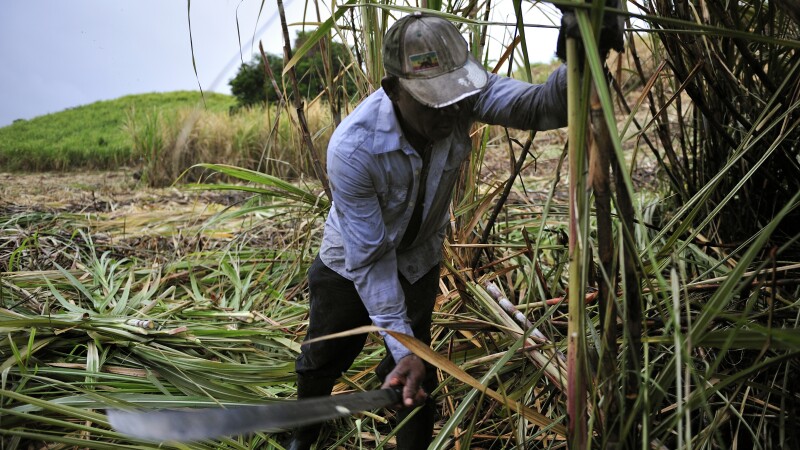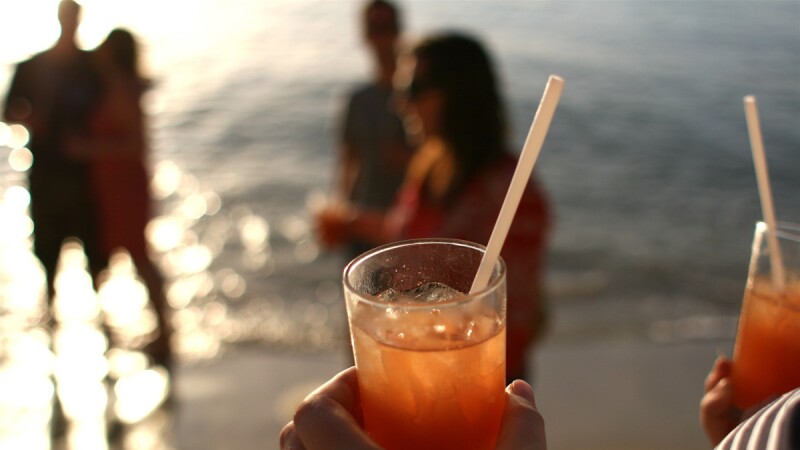When you’re beach-bound in the Caribbean and the rum is calling, you’d better know what you’re getting into. Perhaps more than any other spirit, rum can be difficult to understand thanks to the undefined or unenforced classifications sprinkled across the labels. Consider this your entry-level guide to enjoying Caribbean rum and finding the styles and bottles that suit you best, whether you’re looking for something to sip on, neat, or the perfect match for a cocktail.

A farmer harvests sugarcane for rum in Martinique.
Photo by T photography/Shutterstock
How is rum made?
Rum is distilled from fermented sugarcane by-products and the vast majority of rum—as much as 95 percent—is produced from molasses. This provides many of the rich, dark flavors you likely associate with the spirit, such as brown sugar, maple syrup, and well, molasses.
However, rum can also be made from pressed sugarcane juice, resulting in a lighter, grassier, and more vegetal rum with lingering notes of the sugarcane plant. This is known as rhum agricole, or simply agricole, and is most commonly associated with French-speaking Caribbean islands and nations, like Martinique and Haiti.
Almost all rum is blended; one batch can contain rums of different ages, rums aged in different barrels with different flavor profiles, and even rums made in different ways. Most Caribbean rum is made either with column or pot still distillation or both. Column stills are efficient, industrial behemoths, whereas pot stills are slower and distill to lower strengths but retain more flavor.
Where is rum made?
Rum is made throughout the Caribbean and this region is assuredly rum’s home base. However, other sugarcane producing countries, like India and the Philippines, also make rum.

A range of rums at the Mount Gay visitor center
Photo by Jake Emen
Different islands, different rum styles
Does one Caribbean island reign supreme in the world of rum? That depends entirely on what type of rum you like to drink. While each brand has its own style and flavor, there are also general styles that particular islands have developed over the centuries. Here are a few of the heavy hitters you should become familiar with while exploring different Caribbean rums.
Puerto Rican rum
Puerto Rican rum is known for its light and smooth profile, most typically the result of multiple distillations on column stills. The result is a clean spirit at near-neutral strengths—95 percent alcohol by volume (ABV) or higher—which are typical in vodka production.
Notable Puerto Rican rums:
Jamaican rum
Jamaican rum sits on the opposite side of the flavor spectrum. Expect big, rich rums that take advantage of the pot still’s capacity to retain more flavor during distillation. Get used to tossing around the word “funky” when talking about it; other flavors include sticky-sweet fermented notes, big tropical fruits, bold spiciness, and a hefty molasses influence. Connoisseurs of funky rums from Jamaica (and elsewhere) are ever in search of the elusive “hogo,” a funkier funky, which veers into the addictively rancid territory that stinky cheese devotees know so well.
Notable Jamaican rums:
Bajan (Barbadian) rum
Bajan (Barbadian) rum is typically made from a mix of pot and column still distillation to achieve a balanced flavor profile, incorporating spicy wood notes from the oak, the dark sugars of molasses, and a bit of that big pot-still punch. Rum producers in Barbados emphasize masterful blending of those different distillate components, as well as strategic cask aging.
Notable Bajan rums:
Other Caribbean rums
Is that it? Of course not! Rum is made—and made differently—throughout the Caribbean: There’s the dark, sweet Demerara rum of Guyana, like the earthy, smoky El Dorado; the clean, grassy, and vegetal rhum agricoles like Martinique’s Rhum Clement and Haiti’s Rhum Barbancourt; Dominican rums like Barcelo, which also uses sugarcane juice rather than molasses, and Brugal, which offers a mix of vanilla and oak notes; robust and rich St. Lucian rums such as Chairman’s Reserve.

Rum matures in barrels at Don Q in Puerto Rico.
Photo by Jake Emen
What to look for when choosing rum Island origins aside, there are additional things to look for when choosing a bottle of rum. Here’s how to decipher that rum label.
Maturation: Oldest isn’t always best
Just like whiskey, rum’s flavor profile evolves over time when matured in wood. Depending on the barrel, the process coaxes out new flavors like rich sweetness, tannic spice, and tropical fruit. Most rum is aged in used whiskey barrels, although sherry casks, French oak casks and vats, and other varieties are also used.
While whiskey maturation is tightly regulated, it’s often challenging to determine the true age of a rum. Ideally, the number of years shown on a label should indicate the age of the youngest rum in the bottle, but rules vary widely. The truth is, the number may be a loose average of ages, or it may reference the oldest spirit in the bottle even if it’s only a tiny fraction of the whole, as the case may be with solera aging.
That’s why you should focus less on age and more on intended use when seeking a local expert for guidance. What’s the best local rum for sipping? Which makes the best daiquiri? It’s not always the oldest.
Spiced, navy proof, and beyond
The complicated web of rum classifications only grows denser and more opaque—even cocktail nerds have a hard time interpreting the vague terms people slap on labels such as “dark,” “gold,” and “amber.” Other terms, though, are easier to define.
Spiced rum indicates a rum with added spices and flavorings, like Captain Morgan or Sailor Jerry.
Navy proof and overproof rum refer to stronger rums that clock in well above the typical 40–45 percent ABV. The former is generally bottled at 57 percent; the latter can be anywhere from 60 percent to the infamous, strap-yourself-in strength of 151 proof (75.5 percent).

No matter how it’s made, a rum punch tends to taste best seaside.
Photo by webponce/Flickr
A need-to-know cocktail: rum punch
Regardless of where you’re ordering your rum cocktails, you’ll inevitably come across the rum punch. Sure, crisp daiquiris, zesty mojitos, rich piña coladas, and all the other rum refreshers have their allure, but the rum punch is the Caribbean’s ubiquitous, true specialty.
You can make it yourself, too; just remember the handy Bajan catchphrase: one of sour, two of sweet, three of strong, four of weak. It’s open to interpretation and experimentation, but for a foolproof rum punch, try one part lime juice, two parts simple syrup or sweet fruit juice, three parts rum, and four parts water or light mixer such as coconut water. Or follow the recipe below.
Rum punch cocktail recipe
Makes 2 servings
Ingredients
- 1 oz. lime juice
- 2 oz. pineapple juice
- 3 oz. rum
- 4 0z. coconut water
How to make it
- Place ice cubes in a highball glass to chill
- Add all of the ingredients to the glass
- Stir to combine
- Garnish with a slice of lime and serve
If you’d like to really study up before your next Caribbean trip, consider picking up a book like Fred Minnick’s Rum Curious. Otherwise, you’re now well on your way to being able to decipher any menu or rum shop shelf the islands have to offer.
>>Next: The Caribbean Island Tourists Overlook and Locals Love
This article originally appeared in 2018; it was updated on March 16, 2021, to include current information.











